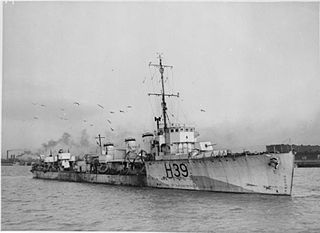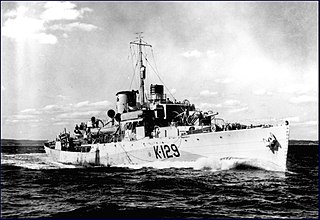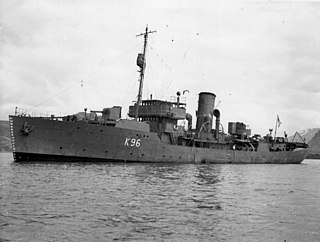Royal Navy Belgian Section
Service in the Antilles and US Coast
On 12 February 1942, Godetia was transferred by the Royal Navy to the newly formed naval branch of the Belgian forces in exile, the Royal Navy, Section Belge (RNSB). [1] Godetia was allocated to the escort group B5 which normally protected North Atlantic convoy routes. Due to severe losses on the American coasts, the group was relocated to the Atlantic coast of the US and the Antilles in 1942. [2] In 1943, she served in the Atlantic and Mediterranean [1] as part of the escort group B5.
In April 1942 she transferred to the American coast with outgoing convoy ON-87. In May and June she escorted four convoys ( OT-2,TO-2, TO-8 and OT-11 ) between Trinidad and Curaçao. In July and August she escorted five convoys ( TAW-1, WAT-5, TAW-9, WAT-15 and TAW-16 ) between Key West and Trinidad via Curaçao. In September, she escorted two convoys between Guantanamo Bay Naval Base and New York City. [3]
On 29 December, the Godetia set out with two tankers from Trinidad to join up with convoy TM 1. According to U-124, [4] its attacks were frustrated by the Godetia and a PBY catalina flying boat, but according to Gasaway, the U-124 attacked the two lone tankers with four torpedoes that malfunctioned or missed, and was then driven off by the catalina which bombed it.
The Godetia then joined her escort group, the destroyer Havelock and the corvettes Saxifrage and Pimpernel to provide escort for TM 1. The convoy TM 1 was an exclusive fast-tanker convoy, bringing urgent fuel supplies to the newly established front in North Africa. During the voyage to Gibraltar, the convoy was attacked by U-boats. The convoy was nearly annihilated, but Godetia is credited with frustrating an attack by U-575 and damaging U-134.
Service in the North Atlantic
After this convoy disaster, the B5 escort group is reformed and return to the North Atlantic. One of the reinforcements for the B5 group is the second Belgian corvette, HMS Buttercup. [6]
Convoy ON-168
The first atlantic convoy to escort is ON-168 in February 1943. Convoy ON-168 is lucky to escape battle with the U-boats when it passes a German patrol line through a gap caused by the undetected loss of a U-boat on 5 March 1943. [7]
Only after 3 days rest in the port of St-John's, Canada, the B5 escort group set out to pick up the Mid Ocean escort for the next convoy SC-122, which was part of one of the major convoy battles of the war.
On 16 March, before the battle really started, Godetia was detached to scuttle a disabled escort trawler HMS Campobello and rescue its crew. It took more than a day before she could catch up with the convoy and Godetia was absent during the first night of U-boat attacks.
As soon as the Godetia rejoined the convoy during the day of the 17th, there was a submerged daylight attack of U-338 which resulted in 1 merchant ship being sunk. Together with another escort, the USS destroyer Upshur, the Godetia retaliated with 3 full pattern depth charge attacks on the boat but without succes. These attacks however drove off the U-338 and also another boat in the vicinity, the U-666.
During the night of the 17th the U-305 made a successful attack and sank 2 ships. Since the rescue ship of the convoy was still lagging behind the convoy after picking up survivors of the previous night attacks, the Godetia was ordered to pick up survivors. During rescue work, the radar of the Godetia picked up the surfaced U-305, and the Godetia gave chase. The U-305 however could dive before Godetias deck gun could engage her, and since the asdic was out of order by this time, a depth charge attack could not be mounted neither and the U-boat escaped unscathed.
Convoy SC-126
After the dramatic passage of SC-122, the next convoy SC-126 in April 1943 was quite uneventful : thanks to good intelligence it could be rerouted and avoid the german patrol lines. [12]
Convoy ONS-7
This was the last convoy escorted during the height of the battle of the Atlantic. It is attacked but after the U-boats sink one ship from the convoy, they lose two of their number to the convoy escort and 2 more to air patrols. This convoy battle is a clear defeat for the German U-boats and it is one of the factors that made the Germans call off their U-boat offensive on the North Atlantic convoy lanes. [13]
Service in the Mid Atlantic
Godetia is in Augustus 1943 detached from EG B5 to help with the escort of convoy UGS-13. [15]
In september she is part of the escort of the small convoy XK-11. [16]
With the Escort Group B5, in October 1943 she takes part in operation Alacrity : the occupation of the Azores Islands. [17]
Service in the English Channel
She was involved in the operations in the English Channel during Operation Overlord. [1] On D-day she was part of force L, the escort group for the follow-up waves on the Britisch-Canadian beaches Juno,Gold and Sword. [18]
Royal Navy
On 16 December 1944, Godetia was re-transferred back to the Royal Navy. [1] The Belgian crew left the ship in order to go back to the previous task of mineclearing. The port of Antwerp had been liberated in september 1944, but its entrances were heavily mined and needed clearing before the port could be put into use again.
In recognition of the role of Godetia's role during the Second World War, the Belgian navy later operated a ship with the same name. Godetia continued to serve (with a British crew) in a convoy escorting role until October 1945 when she was decommissioned. [1]
From April 1942 to May 1945, Godetia escorted 70 convoys. [3]
In 1947, she was scrapped. [1]

The Flower-class corvette was a British class of 294 corvettes used during World War II by the Allied navies particularly as anti-submarine convoy escorts in the Battle of the Atlantic. Royal Navy ships of this class were named after flowers.
During the Battle of the Atlantic, British merchant shipping was formed into convoys for protection against German submarine attack. In March 1943 convoys HX 229 and SC 122 were the focus of the largest convoy battle of the war. Kriegsmarine tactics against convoys employed multiple-submarine wolfpack tactics in nearly simultaneous surface attacks at night. Patrolling aircraft restricted the ability of submarines to converge on convoys during daylight. The North Atlantic winters offered the longest periods of darkness to conceal surfaced submarine operations. The winter of 1942–43 saw the largest number of submarines deployed to the mid-Atlantic before comprehensive anti-submarine aircraft patrols could be extended into that area.
HMS Marigold was a Flower-class corvette of the Royal Navy. She was launched on 4 September 1940 and was sunk by an Italian air-dropped torpedo on 9 December 1942.

Mid-Ocean Escort Force (MOEF) referred to the organisation of anti-submarine escorts for World War II trade convoys between Canada and Newfoundland, and the British Isles. The allocation of United States, British, and Canadian escorts to these convoys reflected preferences of the United States upon their declaration of war, and the organisation persisted through the winter of 1942–43 despite withdrawal of United States ships from the escort groups. By the summer of 1943, United States Atlantic escorts were focused on the faster CU convoys and the UG convoys between Chesapeake Bay and the Mediterranean Sea; and only British and Canadian escorts remained on the HX, SC and ON convoys.

USS Surprise (PG-63), the fourth American naval ship of the name, was a Temptress-class patrol gunboat during World War II. She was built as the British Flower-class corvette HMS Heliotrope, and was in service with the Royal Navy during the first years of the Battle of the Atlantic. She was loaned to and operated by the United States Navy from 1942–1945. After World War II, she was sold as a merchant vessel and ended her life in the Chinese navy as Lin I.

Western Local Escort Force (WLEF) referred to the organization of anti-submarine escorts for World War II trade convoys from North American port cities to the Western Ocean Meeting Point near Newfoundland where ships of the Mid-Ocean Escort Force (MOEF) assumed responsibility for safely delivering the convoys to the British Isles.
HMS Arabis was a Flower-class corvette of the Royal Navy. The ship was commissioned into the Royal Navy as HMS Arabis. She was transferred to the United States Navy in 1942, serving as USS Saucy. Returned to the United Kingdom in 1945, she was recommissioned into the Royal Navy as HMS Snapdragon.

An Escort Group consisted of several small warships organized and trained to operate together protecting trade convoys. Escort groups were a World War II tactical innovation in anti-submarine warfare by the Royal Navy to combat the threat of the Kriegsmarine's "wolfpack" tactics. Early escort groups often contained destroyers, sloops, naval trawlers and, later, corvettes of differing specifications lacking the ability to maneuver together as a flotilla of similar warships, but rigorously trained in anti-submarine tactics to use teamwork emphasizing the unique sensors, weapons, speed, and turning radius of each ship. The development of these 'escort groups' proved an effective means of defending shipping convoys through the Battle of the Atlantic.

HMCS Agassiz was a Flower-class corvette of the Royal Canadian Navy. Named after the community of Agassiz, British Columbia, the ship was constructed by Burrard Dry Dock Co. Ltd. in North Vancouver, British Columbia and was launched on 15 August 1940. The corvette was commissioned on 23 January 1941 in Vancouver, British Columbia. The Flower class were initially designed for coastal service during the Second World War, but due to the demands of the Battle of the Atlantic, Agassiz was used primarily as an ocean escort for convoys crossing the Atlantic Ocean in engagements with German submarines. Following the war, the corvette was sold for scrap.

HMCS Battleford was a Flower-class corvette of the Royal Canadian Navy launched on 15 April 1940 and commissioned on 31 July 1941 during the Second World War. The corvette served primarily in the Battle of the Atlantic, escorting convoys of merchant ships. After the war she was sold to the Venezuelan Navy and renamed Libertad. Libertad was wrecked on 12 April 1949.

Convoy TM 1 was the code name for an Allied convoy during the Second World War. Nine tankers, escorted by Royal Navy warships, attempted to reach Gibraltar from Trinidad. The convoy was attacked by a U-boat wolf pack in the central Atlantic Ocean, and most of the merchant vessels were sunk. This was one of the most successful attacks on Allied supply convoys throughout the entire war. The convoy was defended by the destroyer HMS Havelock, and three Flower-class corvettes, HMS Godetia, HMS Pimpernel and HMS Saxifrage. Seven tankers were sunk during the attacks, two surviving to reach Gibraltar. Two U-boats were damaged during the attacks.

HMS Ekins (K552) was a British Captain-class frigate of the Royal Navy that served during World War II. Originally constructed as a United States Navy Buckley class destroyer escort, she served in the Royal Navy from 1943 to 1945.

HMCS Amherst was a Flower-class corvette of the Royal Canadian Navy. She served primarily in the Battle of the Atlantic on convoy protection duty during the Second World War. She was named for Amherst, Nova Scotia. The ship was laid down at Saint John Dry Dock and Shipbuilding Co. Ltd. in Saint John, New Brunswick, on 23 May 1940 and launched on 3 December later that year. Amherst was commissioned on 5 August 1941 and served in the Battle of the Atlantic and Battle of the St. Lawrence, earning battle honours for both actions. After the war, the ship was decommissioned and sold to Venezuelan Navy in 1945 and renamed Carabobo. However, while en route to Venezuela, the ship was wrecked in the Gulf of St. Lawrence that same year.

HMS Buttercup was a Flower-class corvette built for the Royal Navy. She served during the Second World War first as part of the Royal Navy Section Belge (RNSB), and then later as part of the Royal Norwegian Navy. Between 1946 and 1957 she served as HNoMS Nordyn. The Norwegian government then sold her and she became the whaler Thoris until she was broken up in 1969.

HMS Rochester (L50) was a Shoreham-class sloop of the Royal Navy. She served during the Second World War and was a successful anti-submarine warfare vessel, being credited with the destruction of five U-boats.

HMS Rhododendron was a Flower-class corvette that served with the Royal Navy during the Second World War. She served as an ocean escort in the Battle of the Atlantic.

HMS Aubrietia (K96) was a Flower-class corvette built for the Royal Navy (RN) from 1941-1946. She was active as a convoy escort in the Atlantic and Mediterranean. In May 1941, Aubrietia sighted and depth charged the German submarine U-110, leading to its capture and the seizure of a German Naval Enigma and its Kurzsignale code book.

HMS Delphinium (K77) was a Flower-class corvette built for the Royal Navy (RN) from 1940-1946. From 1941 to 1943 she was active in the Mediterranean as an escort to convoys supporting the Eighth Army and the invasion of Sicily. From mid-1943 onwards she was on convoy escort duties between Africa, the Mediterranean and the United Kingdom; and Atlantic convoys between North America and the United Kingdom. She escorted a total of 68 convoys.

HMS Sunflower was a Flower-class corvette of the Royal Navy. She served during the Second World War.

HMS Petunia (K79) was a Flower-class corvette that served in the Royal Navy and was built by Henry Robb in 1940. She was named after Petunia. Commissioned in 1940, rammed and sold to the Chinese Nationalist Government and renamed ROCS Fu Bo.
















